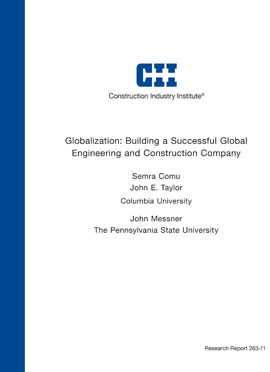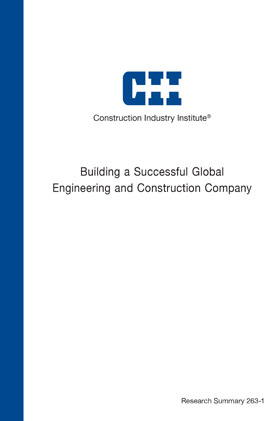
Globalization: Building a Successful Global Engineering and Construction Company
The globalization of engineering and construction services is a component of a much broader trend in the globalization of services, which has far-reaching impacts on work practices, workforce, economy, and society. In the engineering and construction industry, discussions of globalization have centered largely on two main topics: (1) offshore outsourcing (U.S. organizations securing services from offshore service providers such as low cost engineering centers) and (2) global project scope [the increasing size and complexity of projects requiring participation of engineers, contractors, and suppliers from multiple countries]. Yet a third important globalization trend, market issues (U.S. organizations expanding into other countries and international organizations increasingly competing with U.S. organizations domestically), deserves further investigation. The situation in industry today is that trade liberalization is increasing and cost differentials between advanced and developing countries are declining. Market issues are creating a new globalization dynamic making it difficult for engineering and construction organizations to maintain and grow market share domestically and abroad. In the period from 2002 to 2010 the number of U.S. companies on the ENR list of contractors performing the most work outside their domestic market dropped from 36% to 9%. The U.S. engineering and construction industry needs to develop a new understanding of how engineering and construction organizations can evolve beyond users of global resources to ventures that effectively operate in, and integrate into, a global market to reverse this trend.
The CII Globalization Project Team 263 was established to develop a comprehensive understanding of, to synthesize, and to prioritize the key drivers and critical success factors for engineering and construction organizations to become truly global. The purpose of this effort was to increase the success of owners and engineering and construction organizations in the global context. To achieve this purpose, the research team collected case study data utilizing open-ended interviews to identify globalizing dimensions and attributes. The team then utilized the Analytic Hierarchy Process (AHP) to rank and weight the attributes. This led to the development of an implementation tool to enable engineering and construction organizations to evaluate their globalizing progress, to identify and evaluate globalizing tactics to become more global, and to prioritize and plan the implementation of these globalizing tactics. The implementation tool created is titled the Globalizing Self-Assessment Tool (G-SAT). While principally designed for use by engineering and construction companies seeking to understand and improve their globalizing efforts, the G-SAT may be used by engineering and construction companies, owners and suppliers.


